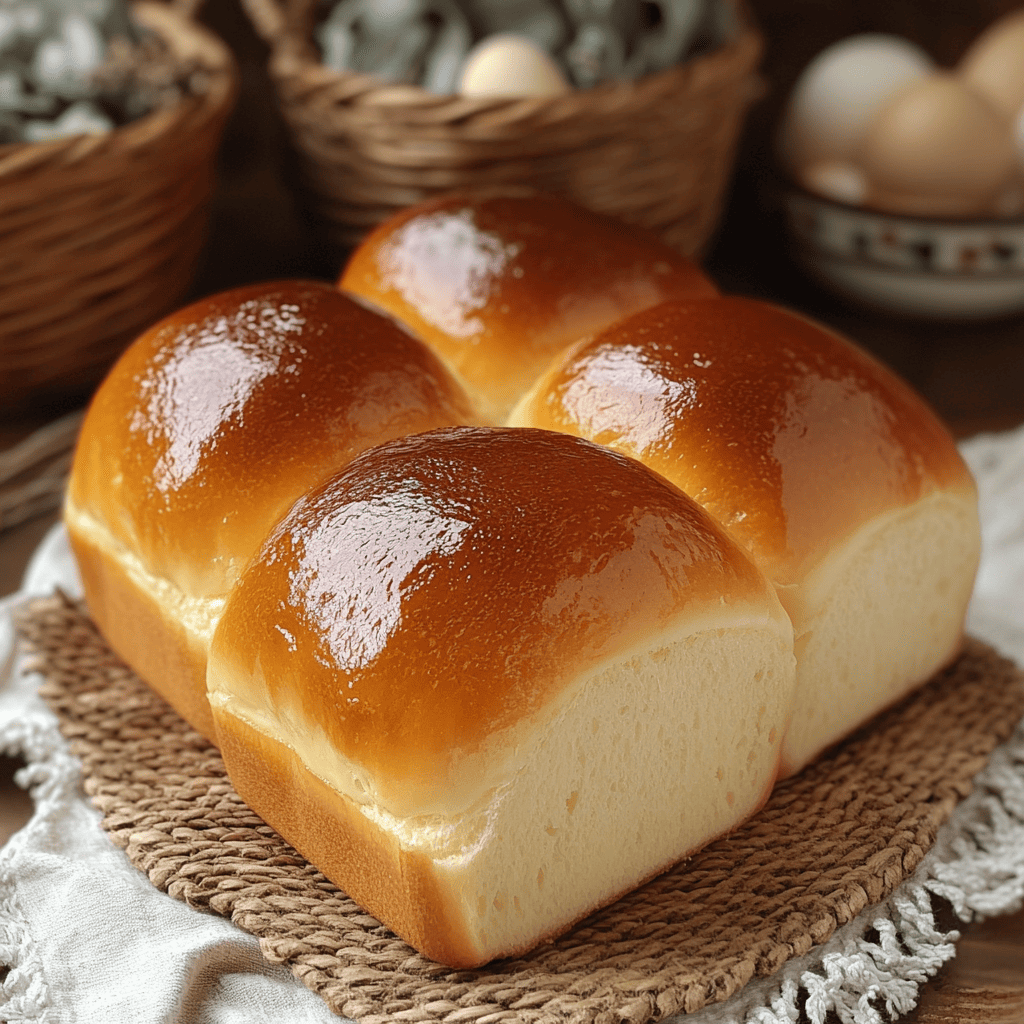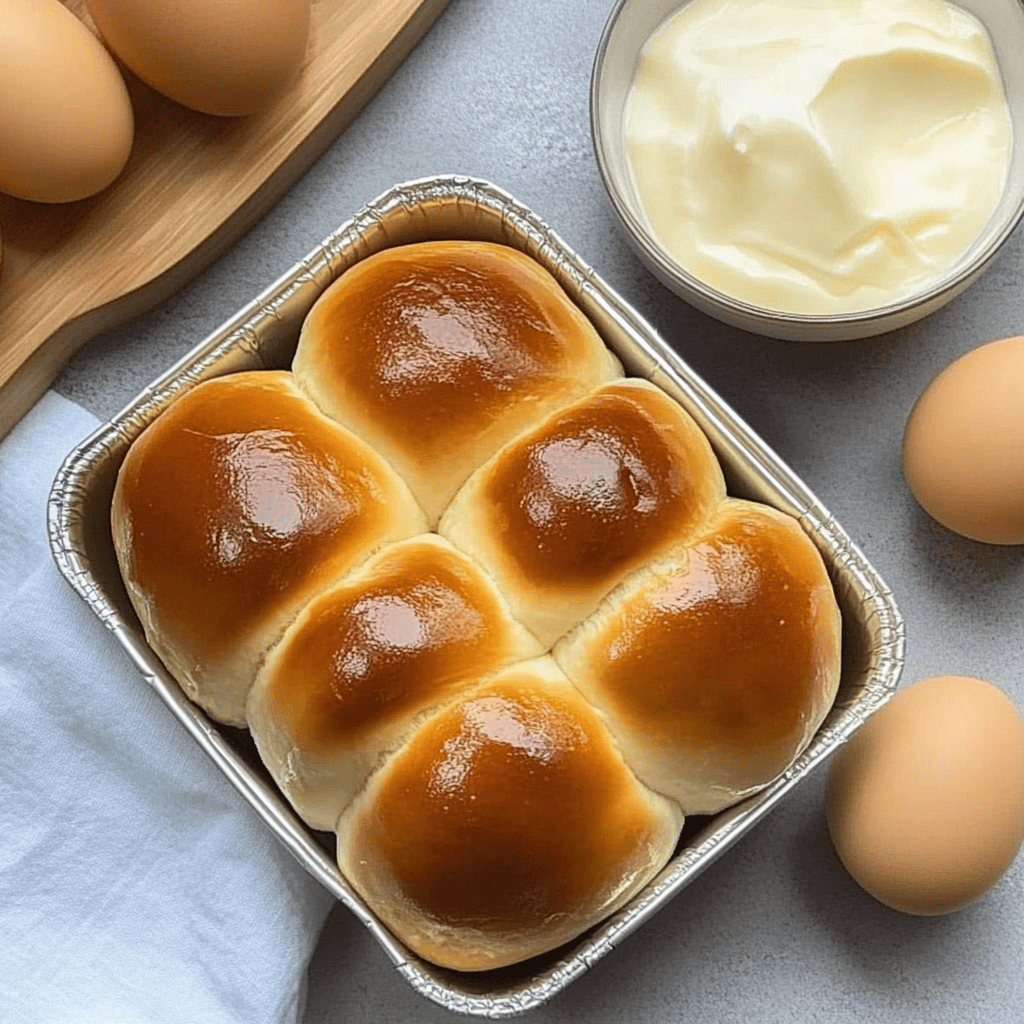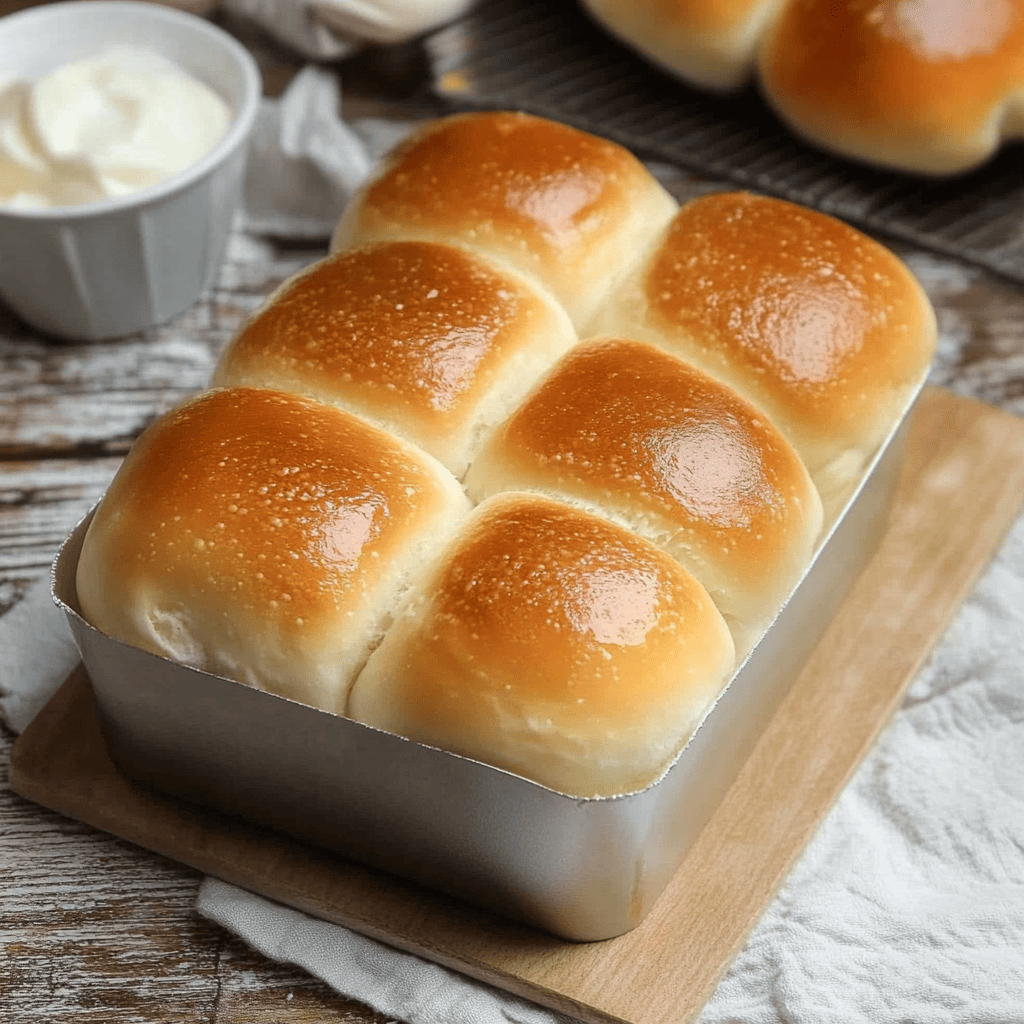Condensed milk bread
Introduction
Condensed milk bread is a delicious variation on sweet bread characterized by its softness, fluffiness, and a slight sweetness provided by the condensed milk. This bread is very popular in various cultures, especially in Asian and Latin American bakeries, where it is enjoyed for both breakfast and snacks. Its tender texture and delicate flavor make it an ideal choice with coffee, tea, or simply enjoyed on its own.
Condensed milk bread is an exquisite sweet bread distinguished by its spongy texture, softness, and slightly sweet flavor. It’s a recipe that has been adapted across cultures, especially in Asian and Latin American bakeries, where it is highly valued for its versatility and ease of preparation.
This bread is ideal for breakfast or a snack, and can be enjoyed alone or with other ingredients such as butter, jam, chocolate, or even sweet or savory fillings. Its main characteristic is the addition of condensed milk , an ingredient that not only adds sweetness but also a tender, moist crumb that stays fresh longer.
The process of making condensed milk bread is relatively simple and accessible for those who want to try their hand at home baking. Its success lies in the correct balance of ingredients and patience during the fermentation process, which results in an airy and soft texture.
Over the years, this bread has become a favorite in many regions of the world, evolving with variations in its preparation and presentation. Today, it’s commonly found in artisanal and commercial bakeries, but its best version remains homemade, prepared with dedication and care.
In this detailed analysis, we’ll explore its history, preparation process, and key characteristics to understand why this bread remains a classic in many cuisines around the world.
History and origin
The use of condensed milk in baking dates back to the 19th century, when this ingredient began to be marketed as a substitute for fresh milk. In Asian bakeries, especially in countries like Japan and South Korea, milk bread became a staple due to its mild flavor and airy texture. Over time, this recipe was adapted around the world, incorporating additional ingredients like butter and egg to achieve an even more tender bread.
In Latin America, condensed milk bread became popular in home and commercial bakeries, becoming a favorite choice for breakfast and snacks. Thanks to the condensed milk, the bread acquires a subtle sweetness without the need for large amounts of sugar.
Condensed milk bread has its roots in the evolution of sweet breads and the invention of condensed milk , a key ingredient that has revolutionized baking and baking in many cultures. To understand its history, it’s important to analyze two key aspects: the development of sweet breads and the emergence of condensed milk as a cooking ingredient.
Origin and History of Condensed Milk in Bakery
Condensed milk was created in the 19th century by inventor Gail Borden in the United States, with the aim of preserving milk for longer periods of time. Over time, this ingredient became popular in baking and pastries, as its sweetness and creamy texture enhance many recipes. In Asia and Latin America, condensed milk became an essential ingredient in breads, desserts, and sweet drinks.
This bread, besides being delicious, is easy to make and perfect for sharing with the family. Would you like more information about any of these sections?
Origin of condensed milk
Condensed milk was invented in the 19th century by Gail Borden , an American entrepreneur looking for a way to preserve milk without refrigeration. In 1856, he patented his condensation process, which involved evaporating much of the water from milk and adding sugar to extend its shelf life. This invention had a huge impact, allowing milk to be stored and transported under optimal conditions, especially during times of war and food crises.
Soon, condensed milk became popular in different countries and began to be used in various pastry and bakery recipes, giving rise to new creations with a creamier flavor and smoother texture.
Evolution of milk bread
Sweet breads have been around for centuries, and many cultures have developed their own versions of breads enriched with milk, butter, and sugar. In Europe, French brioches and British milk rolls are early examples of breads that incorporated dairy products to enhance their texture and flavor.
With the introduction of condensed milk, especially in Asia and Latin America, traditional recipes began to be adapted to take advantage of this ingredient’s properties. Condensed milk not only added sweetness but also contributed to the bread’s moisture and durability, making it an ideal choice for breakfast and snacks.
Popularization and adaptations in the world
Condensed milk bread began to gain popularity in countries like Japan, the Philippines, Brazil, and Mexico , where sweet baked goods have a significant influence on local cuisine. In Japan, for example, Shokupan was developed , an ultra-fluffy milk bread that shares characteristics with condensed milk bread. In Brazil and other Latin American countries, this bread became a common choice in bakeries and homes, often served with coffee or filled with sweet ingredients like dulce de leche or chocolate.
Today, condensed milk bread remains one of the most beloved recipes in home and artisanal baking. Its simplicity and delicious flavor have allowed it to remain popular over time, adapting to new trends and variations across regions. With its combination of softness, sweetness, and unmistakable aroma, this bread continues to conquer palates around the world.

Ingredients and preparation
This bread is made with basic ingredients such as bread flour, yeast, warm milk, butter, egg, and, of course, sweetened condensed milk, which gives it a soft texture and characteristic flavor.
The preparation process follows several fundamental steps:
- Yeast activation : Yeast is mixed with warm milk to ferment and help the bread rise.
- Kneading and fermentation : Combine the dry and wet ingredients and knead until a smooth, elastic dough forms. The dough must then rest until it has doubled in size.
- Forming the portions : The dough is divided into small portions that are placed in a mold to give it its characteristic shape.
- Second rising and baking : The dough is left to rest again before baking at medium temperature until the surface turns golden.
- Cooling and tasting : Allow to cool to achieve its best texture before enjoying it.
Ingredients
For the dough (makes approximately 12 servings):
- 500g of strong flour or bread flour (all-purpose wheat flour can also be used)
- 7 g (1 sachet) of active dry yeast
- 180 ml of warm milk (not hot, to activate the yeast)
- 1 large egg
- 60g unsalted butter , melted and warm
- 120 g of condensed milk
- 1 teaspoon of salt
- Extra: melted butter and condensed milk for brushing (optional)
Step-by-step preparation
1. Yeast activation
- In a small bowl, mix the dry yeast with the warm milk and a teaspoon of sugar (optional).
- Let it sit for 10 minutes until it foams. This indicates the yeast is active.
2. Prepare the dough
- In a large bowl or mixer with a hook attachment, place the flour , salt , egg , condensed milk , and activated yeast mixture .
- Mix until combined and then add the melted butter .
- Knead for 10-15 minutes until you get a soft, elastic and slightly sticky dough .
3. First rising (fermentation)
- Place the dough in a greased bowl, cover with a cloth, and let rise in a warm place for 1 to 1.5 hours , or until it doubles in volume.
4. Form the loaves
- Remove the air from the dough and divide it into 12 equal portions .
- Form into balls or any desired shape and place on a lightly greased tray or mold, leaving space between them.
5. Second rising
- Let it rest again, covered, for 30–45 minutes until they rise again.
6. Bake
- Preheat oven to 180°C (350°F) .
- Brush the surface with beaten egg or milk if you want a shiny golden finish.
- Bake for 18 to 22 minutes or until lightly browned on top .
7. Final and presentation
- Let cool on a wire rack. If you like, you can brush with more condensed milk and a little melted butter on top for shine and extra flavor.
Characteristics of condensed milk bread
- Fluffy and light texture : Thanks to the kneading and fermentation process, an airy and tender crumb is obtained.
- Sweet and delicate flavor : Condensed milk provides a gentle sweetness without being cloying.
- Versatility : It can be enjoyed alone or with butter, jam, chocolate or even fillings like custard.
- Long shelf life : Its natural moisture allows it to stay fresh longer than other types of bread.

Questions about Origin and History
- Who invented condensed milk and in what year?
- How did condensed milk influence the evolution of sweet bakery?
- In which countries did condensed milk bread first become popular?
- What differentiates condensed milk bread from other traditional sweet breads such as brioche or Japanese milk bread?
- How has the original recipe changed over time and in different regions?
Questions about Ingredients and Preparation
- Why is condensed milk used instead of regular milk in this recipe?
- What role does yeast play in bread making?
- Why is it important to let the dough rest before baking?
- How can you improve the texture of bread to make it fluffier?
- What ingredients can be substituted or added to give the bread a different touch?
Questions about Variations and Consumption
- What are some variations of condensed milk bread in different countries?
- What drinks or accompaniments is this bread usually served with?
- Is it possible to make a gluten-free or vegan version of this bread?
- How can bread be preserved so that it lasts longer without losing its freshness?
- What other desserts or recipes can be prepared with a base similar to condensed milk bread?
These questions can help us reflect on the importance and versatility of this bread in gastronomy. Would you like detailed answers to some of them?
More information about Condensed Milk Bread
1. Characteristics of Condensed Milk Bread
Condensed milk bread is a soft, spongy, and slightly sweet bread, ideal for accompanying coffee, hot chocolate, or tea. Its tender texture and delicate flavor make it perfect for breakfast or a snack.
2. Benefits of Condensed Milk in Dough
Condensed milk brings several advantages to the recipe:
- Natural sweetness : Reduces the need to add extra sugar.
- Soft and spongy texture : Thanks to its fat and sugar content, it helps maintain the bread’s moisture.
- Longer shelf life : Condensed milk helps bread stay soft for longer.
3. Variations of Condensed Milk Bread
There are different versions of condensed milk bread around the world. Some options include:
- Stuffed bread : It can be filled with chocolate, jam, pastry cream or dulce de leche.
- Fruit version : Raisins, dried cranberries or candied fruit pieces can be added.
- Condensed milk and coconut bread : Shredded coconut is sprinkled over the top before baking for a tropical touch.
- Savory version : You can reduce the sugar and add grated cheese or herbs for a different flavor.
4. Tips for Perfect Bread
- Proper Kneading : Make sure you knead the dough well to develop the gluten and achieve a fluffy texture.
- Correct rising : Let the dough rest long enough for the bread to rise and become airy.
- Precise baking : Do not open the oven prematurely and ensure the temperature is correct for even baking.
Estimated total preparation time for Sweet Bread with Condensed Milk :
- Dough preparation: 20–25 minutes
- First rising: 1 to 1.5 hours
- Shaping and second rising: 45 minutes
- Baking: 18–22 minutes
- Cooling and decoration: 15 minutes
Approximate total time: 2.5 to 3 hours
This time may vary depending on the ambient temperature and your oven.
Texture and flavor
- Texture: Soft, spongy, slightly moist due to the condensed milk.
- Flavor: Sweet, creamy and buttery, with a tender and delicate crumb.
Consumer context
- Ideal for breakfast , as a snack bread , or to accompany a coffee or hot milk.
- It can be filled with creams, jams or chocolate .
Visual appearance
- Golden balls, soft and shiny when brushed.
- In the form of a braid, rolls or even pull-apart bread .
Curiosities
- This recipe is inspired by Asian sweet breads, such as Japanese milk bread, adapted with ingredients common in Latin America.
- The use of condensed milk as a sweetener and dough softener is highly valued for its dual function .
Estimated nutritional value (per roll)
- Calories: 180–220 kcal
- Carbohydrates: 30 g
- Protein: 4 g
- Fats: 6–8 g
- Sugars: 8–12 g
Additional benefits
- Provides sustained energy through carbohydrates.
- It can be enriched with powdered milk, seeds or dried fruits for greater nutritional value.
- It freezes well, ideal for making in batches and consuming little by little.

Conclusion
Condensed milk bread is a simple yet delicious recipe that combines tradition and flavor in every bite. Its popularity around the world demonstrates its versatility and ability to adapt to different tastes and preferences. Whether prepared at home or purchased at specialized bakeries, this bread remains a perfect choice to accompany any time of day.
Condensed milk bread is a versatile and delicious recipe that combines the softness and sweetness of condensed milk with a light, spongy texture. While it requires patience during the kneading and fermentation process, it results in a tender bread that can be enjoyed alone or with various ingredients, such as jams, butter, or chocolate.
Throughout history, this type of bread has been adopted in various cultures, especially in Latin America and Asia, where condensed milk is an essential ingredient in baking. Its popularity is due not only to its sweet and creamy flavor, but also to its ability to retain the bread’s moisture for longer, making it ideal for breakfasts, snacks, and family celebrations.
Furthermore, the recipe allows for multiple variations, from stuffed versions to options with nuts or tropical flavors, making it adaptable to different tastes and occasions. For best results, it’s important to respect the dough’s resting times, ensure proper kneading, and bake at the right temperature.
In conclusion, condensed milk bread is much more than a recipe; it’s a gastronomic experience that evokes moments of warmth and tradition. Its simplicity and exquisite flavor make it an excellent choice for any lover of homemade bread. Making it at home not only allows you to enjoy its freshness but also to customize it according to your individual preferences. Would you like to try it?

